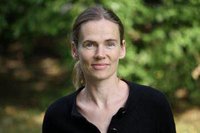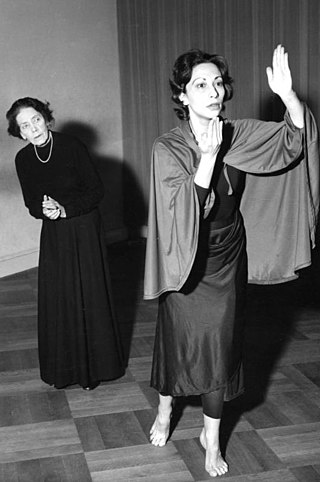
Heike Hennig (born 8 November 1966) is a German dancer, choreographer and director of the opera and dance ensemble "Heike Hennig & Co".

Heike Hennig (born 8 November 1966) is a German dancer, choreographer and director of the opera and dance ensemble "Heike Hennig & Co".
Heike Hennig had her first dance lessons at the age of 5 years in Leipzig of East Germany, studied modern dance, choreography and Body-Mind Centering (BMC) in Cologne and at Moving on Center – School for Participatory Arts and Research in Oakland in US with teachers such as Steve Paxton, worked in Brazil and Portugal.
In 1995, she returned to Germany. From 1998 onwards, worked as a freelance choreographer and teacher. She instructed body- and moving-oriented teaching-methods at the Palucca School of Dance , the University of Leipzig and the Academy of Visual Arts in Leipzig as well as in interdisciplinary workshops including anatomy, painting and choreography.
In 2000, Heike Hennig founded the FZTM (Forum of Contemporary Dance and Music) in Leipzig, together with Friedrich U. Minkus, and her ensemble Heike Hennig & Co. As director she developed numerous stage pieces and interdisciplinary art projects at many different stages and art institutions in Leipzig, Berlin, Dresden and Weimar, among other places. Her team consists of more than 50 artists working in different genres from architects to video artists.
At the Leipzig opera, Heike Hennig developed the dance piece Zeit – tanzen seit 1927 (Time – dancing since 1927) in 2005. This autobiographical dance theater was produced in 2007 as the documentary Tanz mit der Zeit Dancing with Time by the film director Trevor Peters from New Zealand. The film was co-produced with the national German TV-channel ZDF and the French-German TV-channel ARTE. In 2008, the piece was shown in German movie theaters, on TV [1] and in international festivals. [2] Heike Hennig arranged for the former dancers of the Leipzig opera to return on stage. Ursula Cain, Christa Franze, Siegfried Prölß und Horst Dittmann, who at this time were about 80 years old, told and danced their dance and life stories which were shaped by Mary Wigman, Dore Hoyer, Gret Palucca and Heike Hennig. During the shooting, the next dance piece Zeitsprünge (Leaps in Time) was created. here, the protagonists meet up with their younger colleagues in the ensemble Heike Hennig & Co and DJ cfm. The different generations might be recognized from the various dance-styles from Expressionist dance via Street dance and Contact improvisation to classical Ballet. In spring 2008, "Dancing with Time" came out as DVD and a book by the author Marion Appelt with a preface by Renate Schmidt.
For the 2007/08 season, Heike Hennig developed the cross-genre series oper unplugged (Opera unplugged) with music, dance, theater and new media at the Leipzig opera. At the season 2008/09 the cooperation with the baroque ensemble Lautten Compagney Berlin started. This hybridity of cross-genres, which results in the Tanzoper (dance opera) Rituale (Rituals) for George Frideric Handel at the Leipzig opera and the production Timeless at the Neues Museum of the Museum Island Berlin revealed new dimensions for the European contemporary opera. The highlight in 2010 was “Maria” by Heike Hennig, a dance oratorio for three singers, seven dancers, twelve musicians and one DJ on the stage. All artists are part of the choreography with music by George Frideric Handel, Alessandro Scarlatti and electronic music by cfm. [3]
Heike Hennig & Co went on tour through Europe with her cross-genre pieces. They gave guest-performances at Deutsches Schauspielhaus Hamburg, Deutsches Nationaltheater Weimar, Staatsschauspiel Dresden and at theater houses in Athen, Nanjing, Travnik, Goethe-Institut Rom, Copenhagen, Vadstena, Mantua and other cities.
On juries and artistic advisory councils, Heike Hennig makes efforts to support contemporary performing art and music. In 2009, Heike Hennig was invited to teach at the University of British Columbia in Vancouver and Kelowna as well as at Simon Fraser University in Burnaby, Canada as a "Guest Speaker" via film, workshop and lectures. [4] Since 2010, Heike Hennig has taught at the Zurich University of the Arts (ZHdK).

Expressive dance from German Ausdruckstanz, is a form of artistic dance in which the individual and artistic presentation of feelings is an essential part. It emerged as a counter-movement to classical ballet at the beginning of the 20th century in Europe. Traditional ballet was perceived as austere, mechanical and tightly held in fixed and conventional forms. Other designations are modern dance and free dance, expressionist dance or new artistic dance, in Anglo-American countries German dance. In 2014, modern dance with the stylistic forms and mediation forms of rhythmic and expressive dance movements was included in the German List of intangible Cultural Heritage as defined by the UNESCO Convention for the Safeguarding of Intangible Cultural Heritage. German Expressionist dance is related to Tanztheater.

Mary Wigman was a German dancer and choreographer, notable as the pioneer of expressionist dance, dance therapy, and movement training without pointe shoes. She is considered one of the most important figures in the history of modern dance. She became one of the most iconic figures of Weimar German culture and her work was hailed for bringing the deepest of existential experiences to the stage.
Steven Neal Barton was an American actor, singer, dancer, teacher, choreographer, and stage director. He worked internationally in the United States, London, Germany, and Austria productions.

Ruth Berghaus was a German choreographer, opera and theatre director, and artistic director.
Susan Marshall is an American choreographer and the Artistic Director of Susan Marshall & Company. She has held the position of Director of the Program in Dance at Princeton University since 2009.

Grete Wiesenthal was an Austrian dancer, actor, choreographer, and dance teacher. She transformed the Viennese Waltz from a staple of the ballroom into a wildly ecstatic dance. She was trained at the Vienna Court Opera, but left to develop her own more expressive approach, creating ballets to music by Franz Schreker, Clemens von Franckenstein, and Franz Salmhofer, as well as dancing in her own style to the waltzes of Johann Strauss II. She is considered a leading figure in modern dance in Austria.
The Hamburg Ballet is a ballet company based in Hamburg, Germany. Since 1973, it has been directed by the American dancer and choreographer John Neumeier. In addition there is a ballet school, Ballettschule des Hamburg Ballett, established in 1978. The performances of the Hamburg Ballet are usually held at the Hamburg State Opera, while the training and education facility is the "Ballettzentrum Hamburg – John Neumeier".

Sasha Alexandra Waltz is a German choreographer, dancer and leader of the dance company Sasha Waltz and Guests.

Dancing with Time(Tanz mit der Zeit) is a film by Trevor Peters about the autobiography Dance Theater Zeit – tanzen seit 1927 by Heike Hennig.

Ursula Cain was a German dancer and dance teacher.
Reinhild Hoffmann is a German choreographer and dancer who is an important innovator in Tanztheater, along with Pina Bausch and Susanne Linke.
Johann "Hans" Kresnik was an Austrian dancer, and theater director working in the tradition of German Tanztheater who is known for his politically charged approach to dance.

The Palucca University of Dance Dresden, formerly the Palucca School Dresden, is a dance school in Dresden, Germany, founded in 1925 by the dancer and pedagogue Gret Palucca who taught until 1990. The school was recognised as a higher education institution in 1993 and took its current name in 2010.

Martin Dvořák was born in Brno in 1979. He received his professional dance education at the Dance Conservatory in Brno, from which he graduated in 1997. He advanced his education at the Anton Bruckner Privat University in Linz where he enrolled in the master's degree program in Contemporary Dance Movement Research. As a dancer, Dvořák is versatile in various dance styles. He collaborated on a number of projects with the following companies:
Martin Gruber is a German director, choreographer and movement teacher for performing artists.

Isabelle Schad is a German dancer and choreographer.
Inka Unverzagt (married name Ingeborg Schmitz-Unverzagt was a German ballerina, ballet master, choreographer and dance teacher. She worked at the Hans Otto Theater in Potsdam and for DEFA.
Christian Kluttig is a German conductor, pianist and Hochschullehrer. From 1979 to 1990, he was chief conductor of the Orchester des Opernhauses Halle. Appointed General Music Director in 1983, he worked as such at the theatres in Halle (Saale) and Theater Koblenz. The Handel interpreter rendered special services to the implementation of Historically informed performance in the Saale city, which made him one of the most important protagonists in this field in the GDR. He also devoted himself to Neue Musik, premiering Reiner Bredemeyer's opera Candide.
Raimund Hoghe was a German choreographer, dancer, film maker, journalist, and author. Because he was born with scoliosis, his early efforts were focused on journalism. His writings explored the human condition; a documentation series won him an award by the age of 24. For the weekly Die Zeit, he portrayed personalities, the well-to-do, the less fortunate, and those shunned by society. After meeting Pina Bausch while profiling her, he served as dramaturge and chronicler of her Tanztheater from 1980 to 1990. He made his choreographic debut in 1989, then worked independently. His first solo production, Meinwärts in 1994, was about the Jewish tenor and actor Josef Schmidt, but also Hoghe's nonormative body. He was awarded the Deutscher Tanzpreis in 2020, and is regarded as "one of the protagonists of German contemporary dance theatre".
Jochen Ulrich was a German choreographer and dancer.